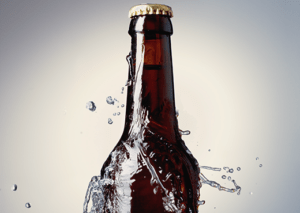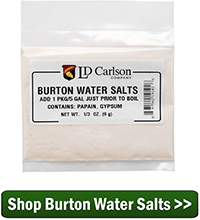Guest blogger Matt Chrispen shares the impact that various minerals can have on different styles of beer. To get the whole story start at Part 1 of this 3 part series.
There is no hard and fast rule in the application of brewing minerals. Every person’s tastes differ. As such, we are exploring the art of “seasoning” the finished beer, like adding a little salt and pepper to your favorite dish. A little may be good, but too much could ruin the batch.
Below are some starting points for 5 gallons of extract beer. Some minerals are already concentrated in the malt extract, so we recommend using reverse osmosis (RO) or distilled (DI) water. When using tap or spring water, reduce the recommendations to taste. Fully dissolve mineral salts in water before the extract is added to boil.
Mineral Recommendations for Different Beer Styles
- Lagers are historically brewed with soft water.
- No mineral additions recommended.
- Malty, Roasty Ales include browns, porters and stouts where malt flavors and sweetness are expected.
- Add ½ tsp (~2 grams) of calcium chloride.
- Hoppy Ales include most American pale ales, hoppy ambers, and IPAs.
- Add ½ tsp (2 grams) to 1 tsp (4 grams) gypsum.
- Mineral-Rich Ales include English bitters or Burton ales.
- Add ½ tsp (2 grams) to 1 tsp (4 grams) each of gypsum ands calcium chloride
Personalizing Additions:
To determine how much mineral(s) might influence your beer, try the procedure below.
- Fill a clean 1-liter bottle or flask with RO water, and dissolving 2 grams of gypsum or calcium chloride. Shake to dissolve completely, creating a 2000 ppm solution of the salt.
- Pick a homebrew and split into four 3-ounce (89 ml) servings. Use gypsum for hoppy or calcium chloride for malty beers.
- Using a calibrated pipette or eyedropper, add 1 milliliter of solution into the first serving, 2 into the second, and so forth. Start with the first serving and work toward the fourth, taking notes.
- Decide
 which serving you prefer. Mark that down. If you preferred serving #4, open another beer and continue the process.
which serving you prefer. Mark that down. If you preferred serving #4, open another beer and continue the process. - Take the serving number (with equivalent number of additions) and do the math:
- The 1 milliliter dose equals 2 milligrams of the salt
- Multiply the preferred dose by 2, yielding the milligrams of salt added
- There are roughly 43 three-ounce samples in 5 gallons
- Multiply the milligrams dosed by 43, yielding milligrams needed for 5 gallons, and divide by 1000 to yield grams. 1 tsp = roughly 2 grams of gypsum or calcium chloride
- Use this amount of mineral salt in your next brew of that recipe!
What changes to you typically make to your brewing water?
———————————————————————-
Series: Part 1 | Part 2 | Part 3
———————————————————————-
Matt Chrispen is a passionate, experienced home brewer, craft beer fanatic, and collector of brewing gear. He also maintains a blog on advanced brewing topics at Accidentalis.com.
———————————————————————-
Sources:
A Brewing Water Chemistry Primer, Homebrewtalk.com, AJ DeLange
Water Treatment for Extract Brewers, Beerandwinejournal.com, C Colby
Water Adjustment in Highly Hopped Beers, Homebrewtalk.com, M Brungard
Calibration Series: Personalized Sulfate and Chloride in Beer, Accidentalis.com, M Chrispen
Bru’n Water, Water Knowledge, M Brungard
How to Brew, John Palmer
